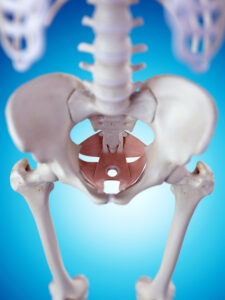There has been growing awareness and promotion for pelvic floor physical therapy.

Many assume that treatment is mostly geared towards females; however, pelvic floor physical therapy benefits males as well! Research shows that 10% of all males experience some form of pelvic pain, erectile dysfunction, and/or incontinence in their lifetime. Yet, we do not see a big push for males to seek treatment for their own pelvic floor issues. There could be several reasons for this – one being the lack of knowledge that males, too, have a pelvic floor.
What is the Male Pelvic Floor Anatomy?
The pelvic floor is a group of muscles that sit at the bottom of the pelvis, acting as a “hammock” by supporting the pelvic organs. These muscles connect from the pubic bone (front) to the tailbone (back), and into the sit bones (sides).
The pelvic floor plays a major role in urinary, bowel, and sexual function by controlling the openings of the muscles, known as sphincters.
They also support the pelvic organs, which in males are the bladder and rectum. Pelvic floor musculature in males and females are actually very similar with the exception that females have a vaginal opening that leads into the uterus.
Males also have a prostate, a walnut-shaped gland that lies between the bladder and penis. It functions in reproduction as it supplies part of the seminal fluid (semen), which mixes with sperm from the testes. Seminal fluid helps the sperm to travel and survive. The prostate can sometimes be a source of pelvic pain in males in the presence of an infection and/or inflammation.
What are Common Symptoms of Male Pelvic Floor Dysfunction?
Another reason why males do not seek out pelvic floor physical therapy immediately is because they may be unsure if it is indicated for their symptoms. Some males may be prescribed unnecessary antibiotics, medications, and procedures to treat their pain and other symptoms when the underlying issue could actually be a pelvic floor dysfunction. In pelvic floor dysfunction, the muscles could be overactive (too tight) or they could be underactive and weak. If you experience any of the symptoms listed below, you should seek out a healthcare professional for a pelvic floor evaluation. The common signs and symptoms of pelvic floor dysfunction in males are:
- Testicular, scrotal, perineal, and penile pain
- Anal pain/spasms
- Erectile dysfunction
- Urinary/fecal incontinence
- Urinary or bowel urgency/frequency
- Constipation
- Low back, hip, groin, lower abdominal pain
What Other Conditions are Associated with Male Pelvic Floor Dysfunction?
It is important to be aware that there could be other underlying diagnoses causing pelvic floor dysfunction and pain. These conditions may include:
- Chronic prostatitis
- Pudendal neuralgia
- Interstitial Cystitis/Painful Bladder Syndrome
- Proctalgia fugax
- GI Disorders (i.e. Irritable bowel syndrome)
If you have one of the listed conditions, you should be managing it with another medical specialist alongside a pelvic floor physical therapist.
So, What’s the Conclusion?
Males and females have pelvic floors that need to be taken care of through treatment and prevention of pelvic floor dysfunction. In pelvic floor physical therapy offered at Rebalance Physical Therapy, you will be evaluated by a specialized physical therapist who will assess for postural, spinal, pelvic, and/or hip abnormalities in addition to pelvic floor dysfunction. They will guide you through a comprehensive treatment plan to address your limitations and help you reach your functional goals to lead a healthy life.
Contact us for more information!
Written by Kimberly Le, PT, DPT
















